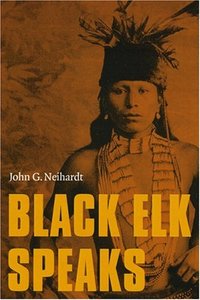 W
WBlack Elk Speaks is a 1932 book by John G. Neihardt, an American poet and writer, who relates the story of Black Elk, an Oglala Lakota medicine man. Black Elk spoke in Lakota and Black Elk's son, Ben Black Elk, who was present during the talks, translated his father's words into English. Neihardt made notes during these talks which he later used as the basis for his book.
 W
WThe Causes of Evolution is a 1932 book on evolution by J.B.S. Haldane, based on a series of January 1931 lectures entitled "A Re-examination of Darwinism". It was influential in the founding of population genetics and the modern synthesis.
 W
WThe Concept of the Political is a 1932 book by the German philosopher and jurist Carl Schmitt, in which the author examines the fundamental nature of the "political" and its place in the modern world.
 W
WD. H. Lawrence: An Unprofessional Study was Anaïs Nin's first book in print, published by Edward W. Titus in Paris, 1932. The original edition saw 550 copies, and was relatively well received in the literary community. It is a study of the works of her literary hero D. H. Lawrence. The book is notable because it was published at a time when many critics were turning their backs on Lawrence. At the time, it was virtually unheard of for a woman to praise Lawrence, a man whose works had been very controversial, and in several cases, banned for their sexual content.
 W
WDeath in the Afternoon is a non-fiction book written by Ernest Hemingway about the ceremony and traditions of Spanish bullfighting, published in 1932. The book provides a look at the history and what Hemingway considers the magnificence of bullfighting. It also contains a deeper contemplation on the nature of fear and courage. While essentially a guide book, there are three main sections: Hemingway's work, pictures, and a glossary of terms.
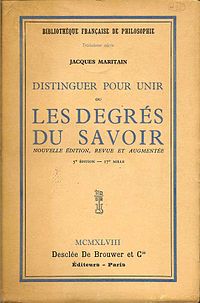 W
WThe Degrees of Knowledge is a 1932 book by the French philosopher Jacques Maritain, in which the author adopts St. Thomas Aquinas’s view called critical realism and applies it to his own epistemological positions. According to critical realism, what we know is identical with what exists, and to know a thing is for its ‘essence’ to exist immaterially in the mind. In The Degrees of Knowledge, Maritain applies this view as he seeks to explain the nature of knowledge, not only in science and philosophy, but also in religious faith and mysticism. Maritain argues that there are different ‘kinds’ and ‘orders’ of knowledge and, within them, different ‘degrees’ determined by the nature of the thing to be known and the ‘degree of abstraction’ involved. The book is divided into two parts: Part one discusses the degrees of knowledge for science and philosophy – or ‘rational knowledge,’ and part two discusses the degrees of knowledge for religious faith and mysticism – or ‘super-rational knowledge.’
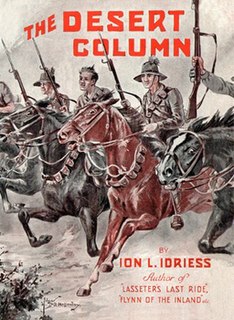 W
WThe Desert Column; leaves from the diary of an Australian trooper in Gallipoli, Sinai and Palestine is a book by Ion Idriess based on a diary he kept of his service during World War I.
 W
WThe Economic and Philosophic Manuscripts of 1844, also referred to as the Paris Manuscripts or as the 1844 Manuscripts, are a series of notes written between April and August 1844 by Karl Marx, published posthumously in 1932.
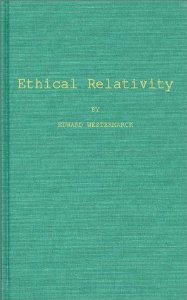 W
WEthical Relativity is a 1932 book by the Finnish philosopher Edvard Westermarck, one of his main works.
 W
WFlynn of the Inland is a biography by Ion Idriess of John Flynn, founder of the Royal Flying Doctors service.
 W
WThe Fun of It is Amelia Earhart's second book after her travelogue 20 Hrs., 40 Min.. In it Earhart recollects how she became interested in being an aviator, which led to her establishing several firsts for women, and also becoming aviation editor for Cosmopolitan Magazine. She also profiles the careers of other pioneering female flyers of her time. Earhart also encourages young women to follow their own careers and dreams. The title comes from her quote "Flying may not be all plain sailing, but the fun of it is worth the price."
 W
WA Garden of Pomegranates is a 160-page book, written by Israel Regardie in 1931. The first edition was published in 1932. The book was printed four times, with a second edition being published in 1970 by Llewellyn Publications. The title pays homage to Moses ben Jacob Cordovero's Pardes Rimonim, or "Pomegranate Orchard."
 W
WGeometry and the Imagination is the English translation of the 1932 book Anschauliche Geometrie by David Hilbert and Stephan Cohn-Vossen.
 W
WThe German Ideology is a set of manuscripts written by Karl Marx and Friedrich Engels around April or early May 1846. Marx and Engels did not find a publisher, but the work was later retrieved and published for the first time in 1932 by David Riazanov through the Marx-Engels Institute in Moscow. The first part of the book is an exposition of Marx's "materialist conception of history", though recent research for the new Marx Engels Gesamtausgabe (MEGA) indicates that much of the 'system' in it was created afterwards by the Marx-Engels Institute in Moscow in the 1930s. Much of the rest of the book consists of many satirical polemics against Bruno Bauer, other Young Hegelians, and Max Stirner's The Ego and Its Own (1844).
 W
WGold Dust and Ashes is a book by Ion Idriess set in Bulolo in the New Guinea goldfields. It covers the history of gold exploration in the region, including occupation by the Germans, transfer to Australian governorship, the efforts of Cecil Levien to pioneer gold mining, and the role of New Guinea Airways in the industry.
 W
WThe Good Quaker in French Legend is a 1932 nonfiction collection of writings by Edith Philips. It discusses French interest in Quakerism and Penn's colony during the eighteenth century.
 W
WHegel's Ontology and the Theory of Historicity is a 1932 book about the philosopher Georg Wilhelm Friedrich Hegel and his theory of historicity by the philosopher Herbert Marcuse. It is influenced by the philosopher Martin Heidegger.
 W
WHistoire de Belgique is a seven-volume survey of the Belgian history by the historian Henri Pirenne (1862–1935) written in French and published between 1900 and 1932. The series, which traces the emergence of the Belgian nation-state from the Roman era until the start of World War I, is a classic of nationalist historiography and one of Pirenne's major works. Although Pirenne is today best known as a historian of Medieval Europe, the Histoire de Belgique series was his most respected work during his lifetime and the foundation of his reputation as Belgium's leading public historian.
 W
WHistory of the Russian Revolution is a two-volume book by Leon Trotsky on the Russian Revolution of 1917. The first volume is dedicated to the political history of February Revolution and the second to that of October Revolution, with the intention of explaining the relations between these two events. The book was initially published in Germany in 1930. The original language is Russian, but it was translated into English by Max Eastman in 1932; in the English translation the second volume, originally consisting of two parts, is split into two volumes. The book was considered anti-stalinist in the Soviet Union, and only made it to publication in Russia as late as in 1997.
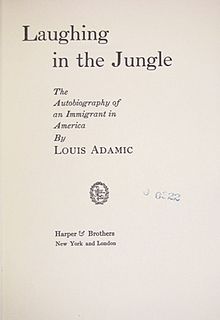 W
WLaughing in the Jungle, published in 1932, is an autobiography by a Slovene-American writer Louis Adamic. As a fourteen year old, Adamic immigrated to the United States in 1913 from Carniola (Kranjska), at that time a part of the Austro-Hungarian Empire. In Adamic’s words, Laughing in the Jungle was an attempt to explain his experiences as an immigrant to America. The title of the book, Laughing in the Jungle, was inspired by Upton Sinclair’s 1906 book The Jungle. Adamic for the first time learned about the book from his Carniolan neighbor, Peter Molek, who said to him that “the whole of America is a jungle… [that] swallows many people who go there to work.” At first, Adamic did not understand Molek’s point, but after sixteen years in America, he came to believe that the United States “is more a jungle than civilization” where one can survive only with “knowledge and understanding of the scene, with a sense of humor.”
 W
WA Letter to a Young Poet was an epistolary letter by Virginia Woolf, written in 1932 to John Lehman, laying out her views on modern poetry.
 W
WLincoln the Unknown is a biography of Abraham Lincoln, written in 1932 by Dale Carnegie. It is published by Dale Carnegie and Associates, and given out as a prize in the Dale Carnegie Course.
 W
WJames Joseph "Gene" Tunney was an American professional boxer who competed from 1915 to 1928. He held the world heavyweight title from 1926 to 1928, and the American light heavyweight title twice between 1922 and 1923. A highly technical boxer, Tunney had a five-fight light heavyweight rivalry with Harry Greb in which he won three, drew once, and lost once, though many ringside reporters believed Greb should have won the decision in their 2nd meeting. He also knocked out Georges Carpentier and defeated Jack Dempsey twice; first in 1926 and again in 1927. Tunney's successful title defense against Dempsey remains one of the most famous bouts in boxing history and is known as The Long Count Fight. He retired undefeated as a heavyweight after his victory over Tom Heeney in 1928, after which Tunney was named Fighter of the Year by The Ring magazine.
 W
WMarie Antoinette: The Portrait of an Average Woman is a 1932 biography of the French queen Marie Antoinette by Austrian writer Stefan Zweig.
 W
WMen of the Jungle is a 1932 book by Ion Idriess. It covered three years in the life of Idriess and his three companions as they worked in north-east Queensland.
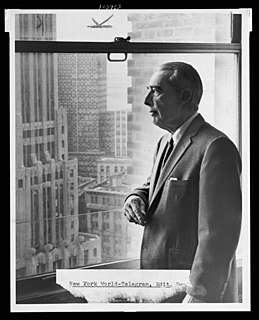 W
WThe Modern Corporation and Private Property is a book written by Adolf Berle and Gardiner Means published in 1932 regarding the foundations of United States corporate law. It explores the evolution of big business through a legal and economic lens, and argues that in the modern world those who legally have ownership over companies have been separated from their control. The second, revised edition was released in 1967. It serves as a foundational text in corporate governance, corporate law, and institutional economics.
 W
WMoral Man and Immoral Society: A Study in Ethics and Politics is a 1932 book by Reinhold Niebuhr, an American Protestant theologian at Union Theological Seminary (UTS) in New York City. The thesis of the book is that people are more likely to sin as members of groups than as individuals. Niebuhr wrote the book in a single summer. He drew the book's contents from his experiences as a pastor in Detroit, Michigan prior to his professorship at UTS. The book attacks liberalism, both secular and religious, and is particularly critical of John Dewey and the Social Gospel. Moral Man and Immoral Society generated much controversy and raised Niebuhr's public profile significantly. Initial reception of the book by liberal Christian critics was negative, but its reputation soon improved as the rise of fascism throughout the 1930s was seen as having been predicted in the book. Soon after the book's publication, Paul Lehmann gave a copy to Dietrich Bonhoeffer, who read it and was impressed by the book's thesis but disliked the book's critique of pacifism. The book eventually gained significant readership among American Jews because, after a period of considerable anti-theological sentiment among Jews in the United States, many Jews began to return to the study of theology and, having no Jewish works of theology to read, turned to Protestant theological works.
 W
WRené-Jean-Marie-Joseph Guénon, also known as ʿAbd al-Wāḥid Yaḥyá [al-Mālikī, al-Ḥāmidī ash-Shādhilī], was a French author and intellectual who remains an influential figure in the domain of metaphysics having written on topics ranging from "sacred science",, to symbolism and initiation.
 W
WA Practical Handbook of British Beetles ISBN 0-900848-91-X is a two-volume work on the British beetle fauna, by Norman H. Joy, first published by H. F. & G. Witherby in January 1932.
 W
WSketches of Etruscan Places and other Italian Essays, or Etruscan Places, is a collection of travel writings by D. H. Lawrence, first published posthumously in 1932. In this book Lawrence contrasted the life affirming world of the Etruscans with the shabbiness of Benito Mussolini's Italy during the late 1920s.
 W
WThe Slovenský náučný slovník is the first general encyclopedia in the Slovak language. It was published in 1932 in three volumes.
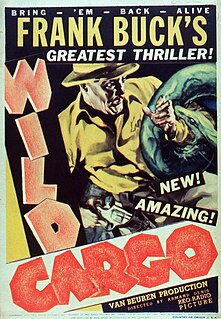 W
WWild Cargo was Frank Buck's second book, a best seller. Buck continued his tales of his adventures capturing exotic animals. Writing with Edward Anthony, Buck related many of his experiences working with jungle creatures.